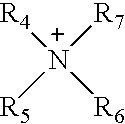Polymer emulsions resistant to biodeterioration
- Summary
- Abstract
- Description
- Claims
- Application Information
AI Technical Summary
Benefits of technology
Problems solved by technology
Method used
Image
Examples
example 1
[0050]The following procedure was used to assess the preservative efficacy of several cationic compounds in an anionic surfactant stabilized VAE copolymer emulsion containing less than 1000 ppm vinyl acetate monomer:
Test Microorganisms
[0051]Aeromonas hydrophilia, Alcaligenes faecalis, Corynebacterium ammoniagenes, Enterobacter aerogenes, Escherichia coli, Klebsiella pneumoniae, Pseudomonas aeruginosa, Proteus vulgaris, Providencia rettgeri, Pseudomonas stutzeri, Shewanella putrefaciens, Serratia liquefaciens, Acinetobacter baumannii, Burkholderia cepacia, Chryseobacterium meningosepticum, Sphingobacterium spiritivorum, Ralstonia pickettii, and Gluconoacetobacter liquefaciens.
Mixed Bacterial Pool Inoculum Preparation
[0052]Each bacterial culture was individually grown on nutrient agar slants, except GABL was grown on potato dextrose agar slants, by inoculating the agar surfaces. The nutrient agar slants were incubated for 24-48 hours at 30° C. and the potato dextrose agar slants were...
example 2
[0058]The biochallenge test procedures were followed as described in Example 1. Table 2 shows the preservative efficacy of various types of cationic compounds, with and without the addition of EDTA salt (ethylenediamine tetraacetic acid, tetrasodium salt) or other metal chelating agents, to control and inhibit the growth of bacteria in AIRFLEX 410 VAE copolymer emulsion having a Tg of ˜4° C., stabilized with nonionic surfactants and containing less than 1000 ppm vinyl acetate monomer. It is clear from the data that there are dramatic differences in preservative efficacy in this polymer emulsion environment depending upon the presence or absence of EDTA salt. For example, a dosage of 300 ppm didecyldimethylammonium chloride exhibits no preservative efficacy by failing the biochallenge test immediately after the first inoculation with the mixed bacterial inoculum. Similar dosages of poly(hexamethylenebiguanide) hydrochloride, CPC (an active antimicrobial agent found in over the counte...
example 3
[0060]The preservative efficacy of several cationic compounds, with and without the addition of EDTA salt, to control and inhibit the growth of mold and yeast in a VAE copolymer emulsion, stabilized with nonionic surfactants and containing less than 1000 ppm vinyl acetate was assessed according to the following procedure:
Yeasts
[0061]Rhodoturula glutinis, Candida guillermondi, and Candida tropicalis, Molds: Geotrichum candidum, Aspergillus species, Sporothrix species, Trichoderma viride, and Cladosporium species.
Mixed Yeast Inoculum Preparation
[0062]Each yeast culture was individually grown on potato dextrose agar plates by inoculating the agar surface. The potato dextrose agar plates were then incubated for 3-7 days at 25° C. After this incubation period, the yeast cells were harvested using quarter strength Ringers solution to wash the colonies off the agar surface. The washings were combined into a sterile, Erlenmeyer flask. The number of plates used and the amount of Ringers solu...
PUM
| Property | Measurement | Unit |
|---|---|---|
| Fraction | aaaaa | aaaaa |
| Fraction | aaaaa | aaaaa |
| Fraction | aaaaa | aaaaa |
Abstract
Description
Claims
Application Information
 Login to View More
Login to View More - R&D
- Intellectual Property
- Life Sciences
- Materials
- Tech Scout
- Unparalleled Data Quality
- Higher Quality Content
- 60% Fewer Hallucinations
Browse by: Latest US Patents, China's latest patents, Technical Efficacy Thesaurus, Application Domain, Technology Topic, Popular Technical Reports.
© 2025 PatSnap. All rights reserved.Legal|Privacy policy|Modern Slavery Act Transparency Statement|Sitemap|About US| Contact US: help@patsnap.com



